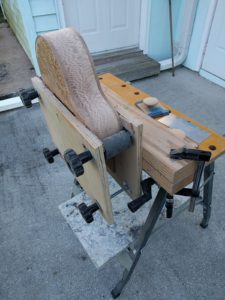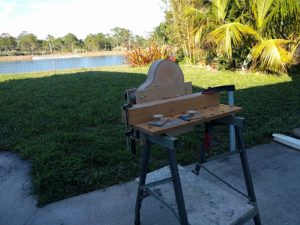The bodies of this latest set are all bound. Now comes a lot of scraping and sanding. First job is to level the binding to the sides. I try to install the binding a little proud of the side since it is much easier to sand the binding down to the side than to sand the whole side down to the binding. To make this sort of operation easier I have made a little portable ‘instrument vise’. This is simply two plywood plates, one of which is screwed to a chunk of 4×4 which is easily clamped to the bench or an outside work table. The other plate rides on 4 long bolts, covered with a bit of foam pipe wrap, with a set of knobs to tighten this plate to hold the instrument. The plates are lined with cork, with one side having the middle cut out so that a convex back is gripped just by the edges. This instrument vise works very well and makes sanding/scraping of sides much easier.
To sand things I use little pads (one visible above on the outside work table) that are simply 3×4 inch pieces of Masonite with wooden cabinet handles glues on. I buy rolls of sticky backed sandpaper (PSA paper) that is quite cheap to buy in a large roll. The rolls come either 3 or 4 inches wide, so a 3×4 pad fits either. Some pads are just Masonite for a really flat surface. Some I face with some 1/8″ cork to allow a little bit of give, and some I face with 1/4″ wetsuit neoprene for a really ‘soft’ surface. These neoprene ones have a smaller Masonite backing so the neoprene hangs out giving an easily curved surface for sanding those inner curves of an instrument body.
These pads, and the support they provide, make things easier on the hands (you are not trying to grip sandpaper around a block) and the paper lasts a long time since it is not flexing as with hand sanding. All of the above however does not change the fact that sanding is not my favorite part of building instruments! Still, when one can take things outside so the dust just blows away, and work on a sunny south Florida day, looking out at the pond, watching the ospreys, things could be worse.

